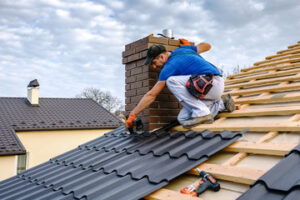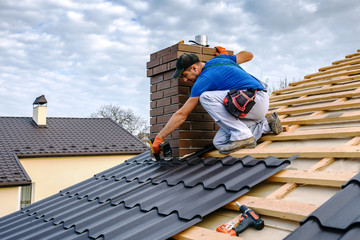Roofing is one of the essential parts of a home. A home can be exposed to the elements and water damage without proper roofing. Roofing materials can be made of natural materials such as slate or clay or manufactured commercially. Which type of material is best depends on various factors, such as the nature of the supporting structure, the roof’s pitch, the area’s climate, and the installation cost. There are a few things that you can do to ensure that your roof will last for years to come.
 Asphalt shingles are a popular choice for most homes. They offer excellent durability and help keep moisture out of the attic. They are lightweight and affordable. They can be installed on various sloping roofs, including flat, low-slope, and steep-slope. These shingles can last up to 50 years. Thermoplastic roof membranes are one of the fastest-growing roofing materials. These are used for flat and low-slope roofs because of their high-temperature tolerance. They also have a unique look and a long lifespan.
Asphalt shingles are a popular choice for most homes. They offer excellent durability and help keep moisture out of the attic. They are lightweight and affordable. They can be installed on various sloping roofs, including flat, low-slope, and steep-slope. These shingles can last up to 50 years. Thermoplastic roof membranes are one of the fastest-growing roofing materials. These are used for flat and low-slope roofs because of their high-temperature tolerance. They also have a unique look and a long lifespan.
Roofing a roof without shingles may seem impossible, but it isn’t. There are a few things you should know before you go about it. First, make sure your roof is in good condition. Many problems can occur with a roof that is old, worn or has been re-roofed. These include blistering, cracking, and discoloration. If you find any of these problems, the roof will need to be repaired or replaced.
The right roofing materials will also contribute to the longevity of your roof. Asphalt shingles are the most popular, but metal and tile roofs can also be durable. These roofing options are a cost-effective way to spruce up your home. They can be purchased at your local home improvement store. You’ll want to ensure your underlayment is waterproof when installing a roof without shingles. This is especially important if you live in a climate that experiences heavy rainfall. You can purchase self-adhesive waterproof underlayment at your local home improvement store.
Detecting a leak on a roof can be a daunting task. Fortunately, several tips and tricks can help you pinpoint the source. Start by checking for signs of water damage, like bulging drywall and stained plywood. You may also find small stains on nails and metal pipes. You can also check for evidence of water leaking into the attic.
You can also use a garden hose to identify the source of a leak. Run the hose in a controlled fashion. It would be best if you only filled it with enough water to isolate the source of the leak. While at it, you can use a flashlight to detect wet spots on the rafters and sheathing. The light will also reveal any bright spots from outside.
During the installation process of a ridge cap, it is important to use a specific set of tools. This will ensure that the roof is installed properly.
The first step in installing a ridge cap is to mark the ridge. This can be done using a carpenter’s pencil. It is recommended that you use a protractor to get an accurate angle. This will help you determine whether you need a larger or smaller ridge cap.
Next, it is important to install the closures. These are designed to keep debris out of your home. The solid closures are usually made of dense foam material. They come in solid and vented varieties. will need to cut a hole in the roof ridge for a vented ridge cap. Then you will need to fit a piece of metal ridge cap over the ridge vent.
Installing starter shingles on the gable ends. During the initial installation phase of a roof, it is important to correctly install starter shingles on the gable ends of the roof. This will help prevent water from penetrating the shingle and prevent wind from blowing it off the roof. You can use the straight up’ or ‘half-tab offset’ methods.
When choosing starter shingles, you should understand how much area your roof will cover. If you’re installing them along the edges of a gable roof, you should measure the length of the eave and rake. You can also use a chalk line to mark a straight line every 6 inches.
Using a nail gun with a lower air compressor setting would be best. This will make driving nails into the starter strip easier without damaging the shingle surface. It’s also important to position the shingles correctly so you can avoid problems later. It would be best if you also were sure not to drive the fasteners into any knot holes or cracks in the roof deck.


